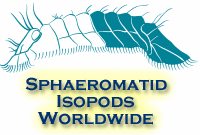| Abstract |
The arthropod macrofauna from the Middle Member of the lithographic limestones of the Tlayua Formation, in quarries at Tepexi, Mexico, is comprised of marine and nonmarine components. Marine taxa include a new species of flabelliferid isopod, a new genus and species of an anomuran, and a new genus and species of a brachyuran crab. Remains of an arachnid and an odonate nymph represent nonmarine constituents. Previous paleoenvironmental interpretations of a restricted lagoon, with periodic episodes of marine and freshwater influences are consistent with the nature of the arthropod fauna. Isopod remains, represented only by corpses, that resemble modem ectoparasites of fishes suggest that they are directly associated with the abundant fish remains found in the quarries, either as ectoparasites that released their hosts before they died or possibly as scavengers that fed on fish remains. The next most abundant arthropods are the crabs, most of which are corpses, suggesting that this group lived in or very near to the depositional site of the Tlayua Formation. Based upon the new fossil material, the stratigraphic range for the Aeglidae has been extended to span Albian to Holocene time. Extant representatives of this family inhabit fresh water environments of South America>
<<Biological Abstracts Vol. 105 Iss. 006 Ref. 079389; English>>
[ANIMALIA; ARACHNIDA; ARCHAEONISCUS ARANGUTHYORUM; ARTHROPOD; ARTHROPODA-UNSPECIFIED; ARTHROPODS; ATOCATLE; ATOCATLE RANULFOI; CHELICERATES; CRETACEOUS; CRUSTACEANS; DESCRIPTION; FOSSIL; GEOGRAPHIC DISTRIBUTION; INSECTS; INVERTEBRATES; ISOPODA; IXTAHUA; IXTAHUA BENJAMINI; MALACOSTRACA; MEXICO; MORPHOLOGY; ODONATA; PALEOBIOLOGY; PALEOZOOLOGY; PROTAEGLA; PROTAEGLA MINISCULA; PUEBLA; SYSTEMATICS; TEPEXI DE RODRIQUEZ; TEPEXICARCINUS; TEPEXICARCINUS TLAYUAENSIS; TLAYUA FORMATION |

















